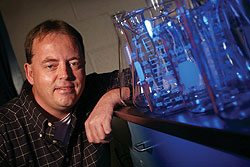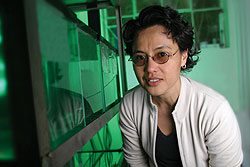
Extending Biomedical Expertise
by Ellen Davis
Program headquartered at NMSU is growing a biomedical research community in New Mexico.
 |
|
Stephen Starnes, an assistant professor of chemistry at NMSU, is among the young faculty members who have benefited from the establishment of the New Mexico Biomedical Research Infrastructure Network, which is now known as the New Mexico IDeA Network of Biomedical Research Excellence (NM-INBRE). The program enabled Starnes to receive mentoring from a chemistry professor at Notre Dame. |
In 2001, Jeffrey Arterburn was a recently tenured faculty member at NMSU who believed in the importance of mentoring to young faculty members. And as a chemist interested in biomedical research, he knew that New Mexico was missing out on important opportunities because there was no collaboration between universities in the state when it came to biomedical research.
So when the National Institutes of Health (NIH) announced plans for a new program that would develop biomedical research programs in states across the country, Arterburn jumped at the opportunity and worked with several other NMSU faculty members to submit a proposal.
The resulting 415-page proposal proved to be a winner, and has been paying dividends for the state ever since.
In late 2001, universities in New Mexico received $5.5 million to create the New Mexico Biomedical Research Infrastructure Network (NM-BRIN). The network was headquartered at NMSU, and included participants from four other universities: the University of New Mexico, Eastern New Mexico University, New Mexico Institute of Mining and Technology and New Mexico Highlands University. Arterburn directs the program.
The concept behind the program was simple: provide nationally known mentors for young faculty members and fund research projects directed by these faculty members that will enable them to develop a track record and eventually compete for their own funding. Funding such projects also would enable these researchers to hire students to assist with the research, exposing students to career opportunities in the biomedical sciences.
“That’s the ultimate benefit of this initiative,” Arterburn says. “Giving students exposure to real research projects gives them
motivation to go on to graduate school and enter biomedical research careers.”
 |
| Funds from the New Mexico Biomedical Research Infrastructure Network have enabled universities across the state to upgrade their biomedical research facilities. NMSU built a new cell culture facility with BRIN funds that is now directed by Graciela Unguez, an assistant professor of biology. The BRIN program also enabled Unguez to receive mentoring from a professor at Purdue University. Photo by Christ Chavez |
The original grant also enabled participating universities to upgrade their biomedical research facilities. NMSU, for example, built a new cell culture facility for its Biology Department and a new lab that enables researchers in biology, chemistry and physics to study the structure of biomedically relevant molecules. BRIN funds also helped Eastern New Mexico University set up a facility where students and faculty members can study biological structures in organisms and molecules.
Young researchers benefit
The original NIH grant funded the mentoring and research of 12 young faculty members from the participating universities. Arterburn notes that two of these researchers have since received RO1 grants from the NIH – the agency’s most prestigious grant to individual researchers. Six of the original 12 faculty members have been granted tenure – a major milestone for young faculty members.
“Many of these faculty members work at institutions where there are no mentors available in their areas of interest,” Arterburn says.
Arterburn says the program has been particularly beneficial to young faculty members who want to conduct research but aren’t at a research-oriented university. A good example of this is Manny Varela, an associate professor of biology at Eastern New Mexico University, who was interested in studying antibiotic-resistant bacteria in agricultural environments such as dairy farms. The BRIN program helped launch his research career, and his studies have attracted national recognition in publications such as the Journal of Dairy Science.
“The BRIN program has been a tremendous boost to our laboratory’s research program,” Varela says.
Among the young researchers at NMSU who were funded by the initial grant was Graciela Unguez, an assistant professor of biology who is interested in tissue regeneration. The program provided funds for Unguez to receive mentoring from Steve Konieczny, a professor of biological sciences at Purdue University, and to pursue studies of an electric fish known as S. macrurus that has the ability to regenerate its spinal cord, skin, skeleton, muscle and electric organ following amputation. Unguez has since been able to land grants from the NIH and the National Cancer Institute, and serves as director of the cell culture facility that NMSU built with the BRIN funds.
“This new facility has allowed us to carry out our work in a setting that is much better than what we had,” Unguez says.
Stephen Starnes, an assistant professor of chemistry at NMSU, also benefited from the first BRIN grant. He received mentoring from Bradley Smith, a professor of chemistry at Notre Dame.
“Bradley has been a tremendous asset to me,” Starnes says. “He is very experienced in my field of research and introduced me to other people in my field.”
The two have gathered some data that Starnes says should result in several publications. At the beginning of the spring 2005 semester, Starnes was named a recipient of one of NMSU’s Donald C. Roush Excellence in Teaching Awards.
In all, Arterburn says the initial BRIN grant exposed more than 100 college students to biomedical research careers. Among these was Paul Wiget, who worked under Starnes while he was an undergraduate studying chemical engineering. Working in Starnes’ lab influenced Wiget to apply for NMSU’s graduate program in chemistry. He now wants to complete his Ph.D. in chemistry and do postdoctoral research at the Scripps Research Institute in California under the same professor with whom Starnes did postdoctoral work.
Program renewed
Last year, institutions participating in the BRIN program received $17.1 million to continue their efforts for another five years. The program has been renamed the New Mexico IDeA Network of Biomedical Research Excellence (NM-INBRE) and the non-profit National Center for Genome Resources in Santa Fe has joined the participating institutions.
The new grant will fund the mentoring and research of 17 young faculty members at the participating universities. Research projects will focus on three areas: understanding the molecular structure and function of proteins that mediate critical cellular processes; learning more about complex physiological processes such as hypertension, memory, cell division and the creation of egg and sperm cells; and understanding pathogens that cause diseases and could be
used for bioterrorism.
Arterburn says these three areas were chosen because they will help extend the state’s expertise in areas such as cancer and diseases emerging along the border.
Another focus of the program will be to develop a statewide training program in bioinformatics. NMSU already is taking the lead on this through the creation of its new Center for Research Excellence in Bioinformatics and Computational Biology (see page 4).
NMSU researchers who will be funded by the new grant are Brad Shuster of Biology, whose mentor is Lynne Cassimeris of Lehigh University; John Gustafson of Biology, whose mentor is Brian Wilkinson of Illinois State University; Kathryn Hanley of Biology, whose mentor is Scott Weaver of the University of Texas Medical Branch at Galveston; and William Lott of Chemistry and Biochemistry, whose mentor is David Peabody from UNM. NMSU will receive a total of $5.5
million over the next five years as a result of the NM-INBRE program.
Statewide networking
Another purpose of the program, Arterburn says, is to bring together students and faculty members throughout New Mexico who are interested in biomedical research.
“Before this program, researchers were isolated at their own institutions and there was no mechanism to bring them together,” he says.
In addition to funding a yearly conference and regular videoconferences, the program pays for top faculty members to give lectures at institutions across the state, including three tribal colleges.
“We’re building up a much more effective group of scientists who can work together and compete for large grants,” Arterburn says. “And we have people doing real research and solving real health problems that can translate into other economic benefits.”
Arterburn says he hopes the cooperation among New Mexico universities fostered by the biomedical research network will extend to other areas as well.
“It is human interactions that make the difference,” he says.
For more information: https://www.nminbre.org/
Contact Us |
|
University Communications MSC 3K Address: New Mexico State University; PO Box 30001; Las Cruces, NM 88003-8001 Phone: (505) 646-3221 E-mail: researchmag@nmsu.edu |
Copyright © 2005 | New Mexico State University


